Capital Unknown Religion Hindu-Buddhist | Government Monarchy Established 2nd century | |
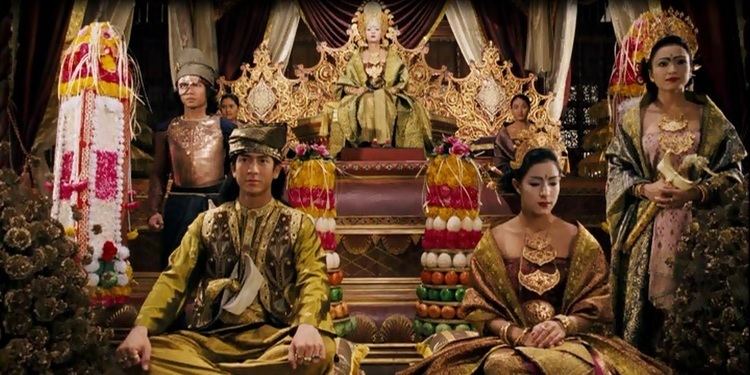 | ||
Langkasuka was an ancient Hindu-Buddhist Malay kingdom located in the Malay Peninsula. The name is Sanskrit in origin; it is thought to be a combination of langkha for "resplendent land" -sukkha for "bliss". According to the legend given in the Kedah Annals, the kingdom was founded and named by Merong Mahawangsa. Another proposal suggests that the name may have been derived from langkha and Ashoka, the legendary Mauryan Hindu warrior king who eventually became a pacifist after embracing the ideals espoused in Buddhism, and that the early Indian colonizers of of the Malay Isthmus named the kingdom Langkasuka in his honour.
Contents
- Queens of langkasuka trailer with english subtitle
- Historical records
- Outline of Langkasukas history
- Location
- Archaeology
- Langkasuka in popular culture
- References
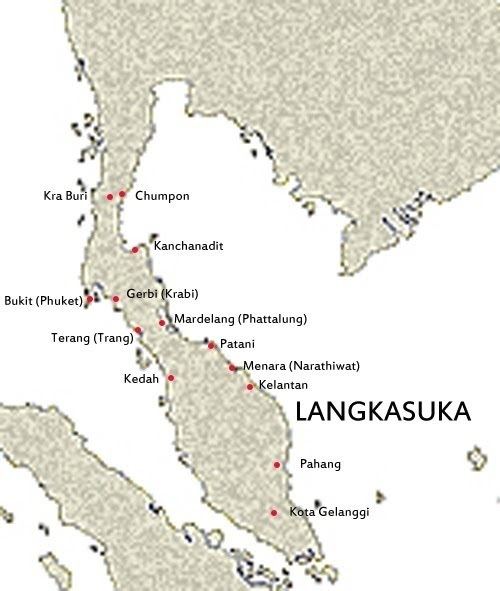
The kingdom, along with Old Kedah, is probably among the earliest kingdoms founded on the Malay Peninsula. The exact location of the kingdom is of some debate, but archaeological discoveries at Yarang near Pattani, Thailand suggest a probable location. The kingdom is believed to have been founded in the 2nd century.
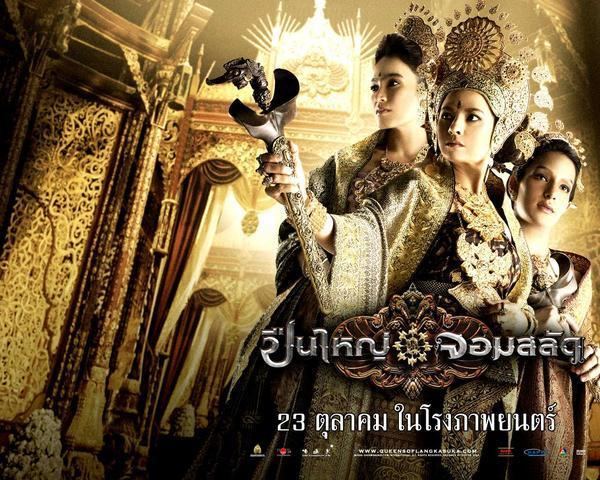
Queens of langkasuka trailer with english subtitle
Historical records
Historical records are sparse. The earliest and most detailed description of the kingdom comes from the Chinese Liang Dynasty (502-557) record Liangshu, which refers to the kingdom of "Lang-ya-xiu" (Chinese: 狼牙脩, Lang-gga-siu in Hokkien) founded in the 2nd century AD. According to Liangshu, "Lang-ya-xiu" or Langkasuka was thirty days' journey from east to west, and twenty from north to south, 24,000 li in distance from Guangzhou. It mentions that Aloeswood (Aquilaria) and camphor were abundant in the kingdom, and its capital was described as being surrounded by walls to form a city with double gates, towers and pavilions. Both men and women in Langkasuka were said to wear sarongs with their torsos bare and their hair loose, although the king and senior officials covered their shoulders with cloth and wore gold earrings and belts of gold cord. Women of high status wrapped themselves in cloth and wore jeweled girdles. It gives further information on some of its kings and also related a story on a succession:
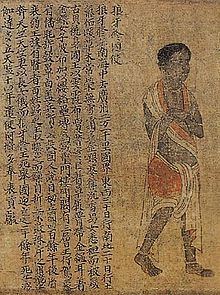
When the king goes forth he rides upon an elephant. He is accompanied by banners, fly-whisks, flags and drums and he is shaded with a white parasol. The soldiers of his guard are well-appointed. The inhabitants of the country say that their state was founded more than four hundred years ago. Subsequently the descendants became weaker, but in the king's household there was a man of virtue to whom the populace turned. When the king heard of this he imprisoned this man, but his chains snapped unaccountably. The king took him for a supernatural being and, not daring to injure him, exiled him from the country, where upon he fled to India. The king of India gave him his eldest daughter in marriage. Not long afterwards, when the king of Langkasuka died, the chief ministers welcomed back the exile and made him king.

This king then ruled for 20 years. He was succeeded by his son, King Bhagadatta, who sent the first ambassadorial mission to China in 515.
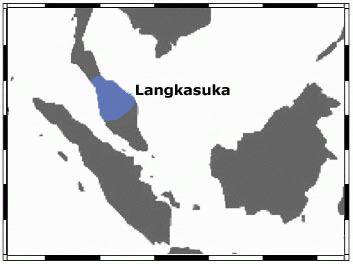
The transcription of the kingdom's name in Chinese records changed over time. In the late seventh century, the Buddhist monk Yi Jing mentioned encountering three Chinese monks who lived in a place named Lang-jia-shu (郎伽戍).
A Song Dynasty work Zhu fan zhi (published in 1225) gives a description of the country of Ling-ya-si-jia (凌牙斯加). It mentions that its people cut their hair and wrapped themselves in a piece of cloth, its products included elephant tusks, rhinoceros horns, types of wood and camphor, and their merchants traded in wine, rice, silk and porcelain. It also says that the country paid tribute to a country named Sanfoqi which is often interpreted to be Srivijaya.
Langkasuka was known as "Long-ya-xi-jiao" (龍牙犀角) in Daoyi Zhilüe from the Yuan Dynasty (1279–1368); and "Lang-xi-jia" (狼西加) during the Ming Dynasty (1368–1644), as marked in the Mao Kun map of Admiral Zheng He .
The country was named "Langkasuka" in the Malay text Hikayat Merong Mahawangsa, and was referred to as "Lengkasuka" in the Javanese poem Nagarakretagama. Tamil sources name "Ilangasoka" as one of Rajendra Chola's conquests in his expedition against the Srivijaya empire. It was described as a kingdom that was "undaunted in fierce battles". Thai sources made no reference to Langkasuka, but Pattani was identified as one of the twelve Naksat cities under the influence of Nakhon Si Thammarat in Thai chronicles.
Outline of Langkasuka's history
A brief outline of the history of Langkasuka can be determined from the limited historical records available. The kingdom is thought to have been founded some time early in the 2nd century AD. It then underwent a period of decline due to the expansion of Funan in the early 3rd century. In the 6th century it experienced a resurgence and began to send emissaries to China. King Bhagadatta first established relations with China in 515 AD, with further embassies sent in 523, 531 and 568. By the 8th century it had probably come under the control of the rising Srivijaya empire. In 1025 it was attacked by the armies of King Rajendra Chola in his campaign against Srivijaya. In the 12th century Langkasuka was a tributary to Srivijaya, and around the 15th century it was replaced by the Pattani Kingdom.
Location
Chinese and Arab sources placed the ancient kingdom on the east coast of the Malay Peninsula. The New Book of Tang mentioned that Langkasuka bordered on Pan Pan, and a map in the Ming Dynasty military treatise Wubei Zhi located it south of Songkla near Pattani River. A 15th century Arab text similarly placed the kingdom south of Songkla. The only contradictory information came from a later Malay text Hikayat Marong Mahawangsa which placed it on the west coast as the predecessor of modern Kedah, although its sovereign had some association with Pattani. Chinese, Arab and Indian sources all considered Kedah and Langkasuka to be separate geographical entities. The Javanese poem Nagarakretagama placed it north of Saiburi, however it appeared to imply that it was originally located on the west coast but was transferred later to the east.
In 1961, taking account of the various sources, the geographer and historian Paul Wheatley concluded that Langkasuka should be located near to the modern town of Pattani. French archaeologist and historian Michel Jacq-Hergoualc'h also suggested that Langkasuka may be located around the former estuary of the Pattani River near Yarang. He also suggested that whole area between Pattani, Saiburi and Yala was part of Langkasuka. Modern archaeological explorations have uncovered ruins near Yarang, a village fifteen kilometers south of Pattani, which may be of the city described in Liangshu. The city was located inland 10 miles from the coast and connected to the rivers leading to the sea via canals. Silting of the waterways may have led to its decline.
Archaeology
Several archaeological expeditions were conducted in the 1960s to locate Langkasuka following the suggestion by Paul Wheatley of its likely location. In 1963, Stewart Wavell led a Cambridge expedition to locate Langkasuka and Tambralinga and the details of this expedition are described in The Naga King's Daughter.
An archaeological investigation of the Yarang area began in 1989 by The Fine Arts Department of Thailand. The majority the ruins were clustered in the vicinity of a hamlet called Ban Wat, and may have formed the nucleus of the city. Others were scattered further to the North at Ban Jalæ, and a couple more at Ban Prawæ. The excavations found various Buddhist structures and objects including votice tablets and sculptures, indicating a strong Buddhist presence in the kingdom. Objects related to Hindu worship were also found.
Many Chinese and Arab coins made of bronze have been found in the region, an indication of the commercial activity of the kingdom. Two silver Sassanid coins have also been found.
Langkasuka in popular culture
The kingdom has been made as either a subject or setting of several films:
